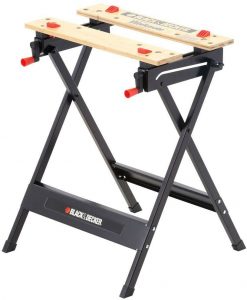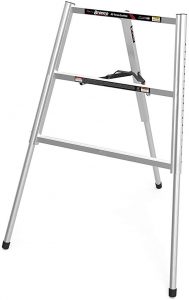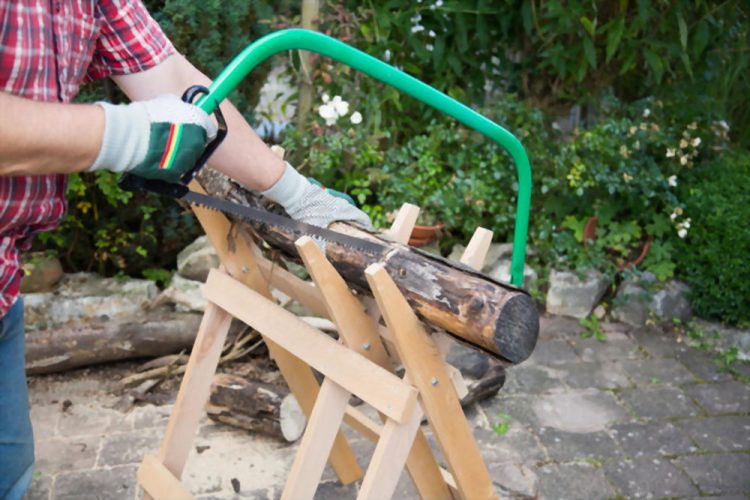There are many different things you can do with a couple of sawhorses. You can use them to support flat and heavy surfaces like doors, wooden boards and other. They also work as workbenches to cut, paint or repair things. You can even take a couple of these to your next outdoor adventure and turn it into a convenient picnic table by adding a piece of plywood.
Professional carpenters use high-quality sawhorses all the time to cut wood and perform other important activities. So, if you’re a beginner carpenter, you must learn how to use a sawhorse well to become a master.
Today, we’ll explain you all the different ways you can use these versatile tools that can’t be missing in your DIY projects.
How to Use a Sawhorse? – Everything You Need to Know
1. Workbench

Not many people have enough money to buy big workbenches or the space to store them in their homes. Most workbenches are too heavy, so you can’t take them with you to work outdoors.
A pair of sawhorses and a flat surface on the top is all you need to have your own workbench for less than half the money. Best of all, it will only take you a couple of minutes to assemble the whole thing.
To ensure that your workbench won’t break apart during work, you can join the plywood panel to both sawhorses using long screws. You can also include a third sawhorse on the center for greater stability.
2. Scaffolding

Many times, you need something more stable than a scissor ladder when working at height. In those cases, scaffoldings can provide more stable support and less vibration transmission. However, professional steel scaffoldings cost too much money. In addition, they may be too large for simple household duties.
Fortunately, you can use your homemade sawhorses as scaffoldings. In these cases, be sure to add wooden braces to reinforce the structure. That way, you’ll be less likely to break the legs apart and fall to the ground.
Also, make sure you use a surface that’s strong enough to withstand your weight. Join it to the sawhorse with clamps or fasteners to avoid slips.
3. Drying rack
During your carpentry projects, you’ll need a place to put your wooden pieces covered with wet paint or varnish. For these cases, you just need to place outdoors a pair of sawhorses and a flat surface on the top to use it as a drying rack.
You can also use this configuration to dry whatever you want including ceramic pieces, paintings or even food.
4. Jobsite Table

If you’re already using your sawhorses on a workbench, you can join additional wooden panels to the braces. That way, you can have more space to put some other things. Even, you can use this as a rustic jobsite table. You can place your books, notebooks, laptop or whatever you want on it.
5. Space buffer
Sometimes, job site conditions can endanger other people. Situations like these are common in construction sites, chemical industries, and others. People often use “don’t cross” tapes to keep the curious away from the place.
In these cases, you just need to hold the tape on the things you have around, like poles or barrels. But what can you do when you’re working in a completely cleared area? The answer is simple. Use sawhorses.
Locate sawhorses at strategic sites to set the corners of the restricted area. Set something heavy on the sawhorses so they don’t move or fall with the wind.
6. Cutting grid
If you need to cut a wooden board at a construction site, you don’t have much time to waste. So, taking your lumber to a carpentry workshop isn’t an option. In that case, you can build your own cutting grid using a pair of saw horses holding a rigid surface.
Plywood panels may be too heavy and difficult to move. But, you can use something lighter like rigid foam insulation panels. Rigid foam doesn’t wear the blade while you’re cutting, which makes it the perfect surface for your cutting grid.
How to Use a Sawhorse: Essential Sawhorse Use Tips
- Join a piece of 2X6 board on the top of each sawhorse that work as a sacrificial surfaces. That way, you can use a circular or mitter saw without accidentally cutting the frames.
- Install plastic chair caps on each of the legs of your sawhorses so as not to scratch the floor.
- Drill a hole below the I-Beam of your sawhorse. Then, hang a carabiner from the hole and use it as a safe support for your tools’ wires. That way, the wires won’t touch the wet ground, preventing short circuits.
- Install a secondary wooden panel between the braces of two sawhorses and use it as a storage shelf. There, you can place all your tools without the risk of leaving them forgotten on the floor or elsewhere.
Conclusion
Certainly, sawhorses are useful for many purposes. They are so much beneficial that many even try to make their own sawhorse. With minor modifications, you can perform a lot of activities with them. You can cut a piece of wood and store the rest of your tools at the same time. Best of all, they’re light, versatile and easy to use.
Now that you know how to use a sawhorse like a pro, you’ll no longer need to buy new workbenches or scaffoldings to perform a certain task. All you need is a little imagination, a piece of plywood and a couple of sawhorses.
FAQs
Q. What’s the purpose of a sawhorse?
A. The main purpose of a sawhorse is to provide a stable support to perform different activities. Sawhorses are also lightweight and easy to carry, which makes them perfect for all kinds of outdoor projects.
Q. How tall a sawhorse should be?
A. Usually, the standard height of saw horses varies between 30-32 inches. Some models are shorter, reaching 20-24 inches in height, so the user can support their knees on wooden boards so they don’t move while cutting.
Also, some plastic models allow you to adjust the height by varying the inclination of the legs.
Q. What angle are sawhorse legs?
A. To provide maximum stability, the legs should slope between 65-75 degrees.
Q. How much weight can a sawhorse hold?
A. Sawhorses can withstand different weight ranges depending on their design and materials. However, most commercial models can withstand at least 1000 lbs.








